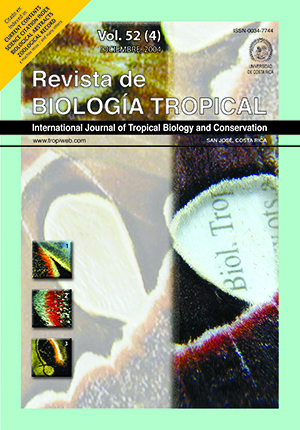Abstract
The globally vulnerable Clyomys bishopi, a semi-fossorial and colonial rodent, is apparently limited to cerrado (savannah-like vegetation) physiognomies in São Paulo State, Brazil. The aim of the study was to verify whether the presence of C. bishopi is associated to the occurrence of palm trees (Attalea gearensis, Syagrus loefgrenii) and armadillo burrows. Thirty six quadrats were placed in different physiognomies of cerrado vegetation at Itirapina Ecological Station, southeastern Brazil to survey the number of C. bishopi burrows of individuals of palm trees and burrows of armadillos. There was a strong dependence and association between the number of C. bishopi burrows and all measured variables (Contingency tables and Spearman rank correlations). It is suggested that this rodent can be found in great numbers where palm trees are abundant. The use of armadillo burrows possibly makes the movement of the rodents easier inside their own galleries
References
Avila-Pires, F.D. & M.R.C. Wutke. 1981. Taxonomia e evolução de Clyomys Thomas 1916 (Rodentia, Echymyidae). Rev. Brasil. Biol. 41: 529-534.
Cunha, M.J. & S.C. Belentani. 2000. Descrição das galerias de Clyomys bishopi (Rodentia, Echimyidae) p. 142- 152. In M.R.C. Martins, W. Mantovani, J.P. Metzger (orgs.). Livro da Disciplina Ecologia de Campo. Universidade de São Paulo, São Paulo. Brasil.
Giannotti, E. 1988. Composição florística e estrutura fitossociológica da vegetação de Cerrado e de transição
entre Cerrado e Mata ciliar da Estação Experimental de Itirapina (SP). Dissertation. Universidade Estadual de Campinas. Campinas. Brasil.
Mantovani, W. 1987. Análise florística e fitossociológica do estrato herbáceo-subarbustivo do Cerrado na reserva biológica de Guaçu e Itirapina. Ph. D. Thesis. Universidade Estadual de Campinas. Campinas. Brasil.
Nowak, R.M. 1999. Walker´s Mammals of the World. Volume II. The John Hopkins University, Baltimore and London. 1101 p.
Siegel, S. & N.J. Castellan-Jr. 1988. Nonparametric statistics for the behavioural sciences. McGraw-Hill, New York. 399 p.
Vieira, M.V. 1997. Dynamics of a rodent assemblage in a cerrado of southeast Brazil. Rev. Brasil. Biol. 57: 99-107.
Zar, J.H. 1984. Biostatistical analysis. Englewood Cliffs. 718 p.
Comments

This work is licensed under a Creative Commons Attribution 4.0 International License.
Copyright (c) 2004 Revista de Biología Tropical


